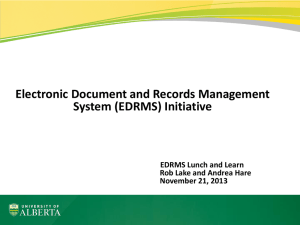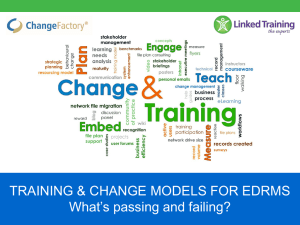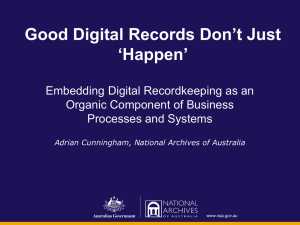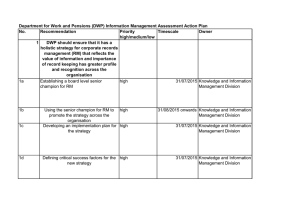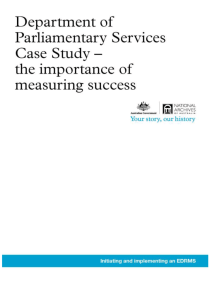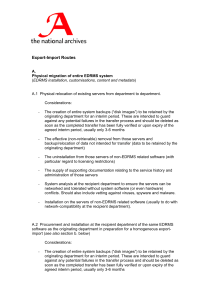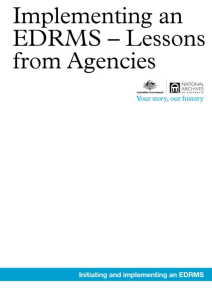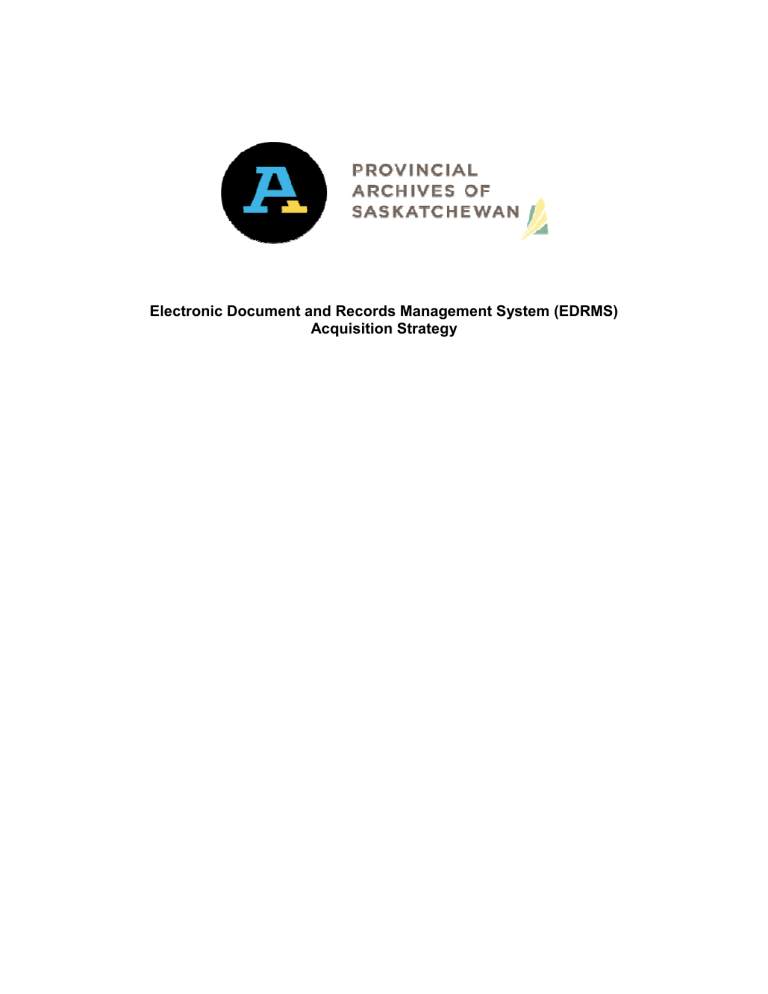
Electronic Document and Records Management System (EDRMS) Acquisition Strategy Introduction The mandate of the Provincial Archives of Saskatchewan (PAS) is to acquire, preserve and make available public and private records of significance to the Province of Saskatchewan The Archives is also responsible for providing advice and assistance to “government institutions, ministers’ offices, the Legislative Assembly Service, officers of the Legislative Assembly and the courts concerning standards and procedures pertaining to the management of records.” This document outlines what electronic document and records management systems (EDRMS) are, what business benefits they can provide and their limitations. It provides a framework to help facilitate the acquisition of an EDRMS and highlights key issues that an organization will need to consider in order to achieve a successful EDRMS implementation. This information may assist government institutions in assessing their readiness for EDRMS implementation and in deciding on a suitable solution that meets the needs of the organization. It does not, however, focus on the specifics of IT infrastructure requirements. Institutions will need to consult with their IT provider in order to secure advice and partnership. Legislation The Archives and Public Records Management Act establishes records management framework for government institutions and facilitates the means by which public records can be destroyed or transferred to the Archives. The Act requires that every institution or office that is subject to the Act “protect and maintain all public records,so that those public records are, considering the purposes for which they are being maintained: (i) useable and accessible; (ii) transferable; (iii) legible and understandable; (iv) maintained in a format and in a condition that ensures their retention and preservation in accordance with the applicable approved records schedule; and (v) if applicable, capable of being transferred to the Provincial Archives of Saskatchewan in a format acceptable to the Provincial Archives of Saskatchewan.” Managing the Digital Record The Archives and Public Records Management Act is media neutral, meaning that it applies equally to records in all media/formats including paper, sound, visual, electronic, etc. Digital records must be effectively managed and preserved over time in order to meet the legislative requirements of the Act. The Act also requires that these records be managed in an environment which has the capacity to do the following: • • capture and identify records in the context of creator(s) and their business activities apply appropriate controls to ensure integrity 2 • • • • apply established retention periods as per an approved retention schedule and document disposition facilitate search and retrieval based on metadata provide administrative control of the recordkeeping system (system audits) facilitate the transfer of records to another system, to archival custody or allow for destruction of records following the Archives’ records disposal process What is an EDRMS? An EDRMS is a software application that is used to manage digital information. The software provides a framework for the capture, maintenance and accessibility of records over time. EDRMS are specifically designed to manage the integrity of, and provide desktop access to information using existing office applications such as email, collaborative work systems and other applications already installed. An EDRMS combines document management and records management functionality. This functionality can include the following: • • • • • • • • • • • • registers and organizes documents in a secure central repository assigns unique identifiers to records describes records according to approved terms allows collaboration on documents by multiple users captures metadata such as creator(s), dates, versions, etc. facilitates search and retrieval allows monitoring of access and use of documents allows records to be classified and retention periods assigned according to specific records schedules (ARMS2014 or ORS) facilitates the disposition process facilitates the appraisal and eventual transfer of records deemed to have historical significance to the PAS applies appropriate security classifications and ensures integrity and authenticity provides appropriate audit trails An EDRMS is able to integrate and interface with existing paper file systems to: • capture the creation of paper records • maintain and manage metadata on paper records • facilitate access and retrieval • track movement of physical files • manage physical storage facilities • manage the retention and disposition of paper records Benefits of an EDRMS By improving the management of information, an EDRMS can increase business efficiency, provide greater accountability and reduce business risks. By ensuring that 3 official public records are appropriately managed, secured and accessible, the software can assist organizations in complying with legislative requirements. Improved Records Management capability • Provide a central repository for records • Manage email more effectively as records • Facilitate more efficient access to information through consistency in naming and titling • Manage the appropriate disposition of records (destruction or transfer to Archives) • Facilitate records management processes such as classification of records, assigning retention periods and applying metadata • Link related records • Allow for integration with other business systems and collaborative work systems to access related information • Facilitate management of paper records by incorporating tracking controls Increased business efficiency • Reduce reliance on paper records, decreasing physical storage costs • Enable staff to view, read or share information simultaneously • Reduce duplication by capturing information only once • Facilitate sharing and reuse of information across work groups • Potentially streamline and automate work practices and business processes such as workflow and approvals Reduced risk • Ensure information is reliable and the latest version is available • Provide greater security and access control features to reduce the risk of information being inappropriately accessed, altered or deleted • Audit trails to prove who had access to information and its workflow • Ability to prove the integrity and authenticity of information in legal proceedings • Potential improvement in decision-making through access to the latest, most comprehensive information • Better ability to respond to freedom of information requests and discovery orders in a comprehensive and timely fashion Legislative Compliance By ensuring that official public records are properly managed, an EDRMS can assist in compliance with legislative requirements, including: • The Archives and Public Records Management Act • The Freedom of Information and Protection of Privacy Act (FOIPP) • The Evidence Act • The Health Information and Protection of Privacy Act (HIPPA) • The Electronic Information and Documents Act Limitations of an EDRMS An EDRMS alone cannot address records management requirements. An EDRMS is enabling technology; implementation must be based on an established records 4 management program, including approved retention schedules, policies and procedures. Tools and training will need to be provided to guide change management. EDRMS products and the functionality they provide are continually evolving and maturing. However, the majority of offerings in the current EDRMS market will not provide the following types of functionality: • • • • Managing structured data stored within line-of-business systems (Human Resource or Finance systems) Managing the dynamic life cycle of web pages or systems Providing advanced document management Establishing records management controls Implementing an EDRMS Following are issues that an organization must take into account when considering the implementation of an EDRMS. 1. Records Management Requirements The first step in considering the acquisition of an EDRMS is to have an established records management program in place. This should include dedicated resources and staff as well as the implementation of approved records retention schedules and internal records management policies and procedures. Records schedules are tools that identify groups of records based on the functions of an organization and assign minimum retention periods to each grouping. In Saskatchewan, there are three types of record schedules: ARMS2014 for classification of administrative records, Operational Record Systems (ORS) for scheduling operational records and Comprehensive, Corporate-Wide Records Schedules for use by Crown Corporations. Records schedules must be integrated into any EDRMS environment in order to allow digital information to be effectively managed and retained for as long as it is required to fulfill legal and business purposes. Schedules also ensure that records are not kept longer than required, allowing compliance with privacy requirements. Institutions must also have internal records management policies and procedures in place to assist in the implementation of an EDRMS. These can include naming conventions, filing practices, e-mail and electronic records management, disposal procedures for official and transitory records, etc. Organizations must request approval from the Provincial Archivist for disposal of records when retention requirements, as defined in an approved records schedule, have been met. 2. Information Management Structure and Organizational Requirements An assessment of the current state of an organization’s information management program, including systems that are in use and staff practices, should be undertaken. 5 This will assist with issues such as integration with other systems, system configuration and the development of appropriate business rules. Once the institutional RM program has been assessed, the IMU can help to identify areas of concern and provide advice on improvement prior to an EDRMS implementation. Analysis of current and future business requirements should be done before beginning an EDRMS implementation project. The analysis should include, but is not limited to, an agency-wide assessment of current business practices, information managed by the organization, existing computer systems/applications and all current records management policies and procedures including records retention schedules. 3. Resource Commitment An EDRMS implementation is a major project, requiring a significant commitment of time, money and staff. The resource requirements will depend on factors such as an organization’s size, its business requirements and the amount of configuration necessary. Obtaining and securing sustained senior management commitment for the necessary resources for EDRMS implementation is key. Also, ensure the availability of dedicated Records Management staff to work on the implementation and to provide on-going support once the system is running. Specific tasks requiring resources include: • understanding the organization’s business and information needs • documenting requirements • establishing records management controls • selecting an appropriate software solution • procuring a licence • engaging with stakeholders and end users, and managing change • developing business rules and procedures to operate the system • configuring the system to organizational needs • developing the necessary back-end IT hardware • testing the system prior to implementation • ongoing training, maintenance and support. The budget for implementing an EDRMS will depend on: • level of functionality rolled out • extent of customisation • complexity of configuration needed to satisfy business needs • work areas of the organization to be included • level of records management control • extent of integration or interface with other business systems. • required infrastructure to administer the system, administer on-boarding training, etc. 6 4. Knowledge and Skills EDRMS implementation involves rolling out new software and improving records and information management practices. Close collaboration between records management personnel and IT stakeholders is essential to ensure the broadest understanding of requirements and to maximise the implementation’s benefits. To successfully implement an EDRMS, an organization will need to draw on skills, knowledge and expertise in the following areas: • records and information management to set up processes and establish a records management framework • IT to work on the technical architecture, systems integration and desktop rollout • project management • change management to manage the impact at all levels of the organization, including the way information is created, managed and accessed • business analysis to assist in mapping business requirements and identifying improvements • information security. Consider engaging an external consultant with specific experience in EDRMS implementation if these capabilities are not available internally. 5. Policies, Guidelines and Standards The following records management policies and guidelines must be taken into account when considering requirements for implementing an EDRMS: • Saskatchewan Records Management Policy, • Basic Records Management Practices for Saskatchewan Government • Email Management Guidelines • Government of Saskatchewan Records Disposal System, • Records Schedules (ARMS2014, ORS or Comprehensive, Corporate-Wide Schedules) • Source Records Disposal Policy, • Transitory Records Policy • Naming Conventions For further information please visit the PAS website at www.saskarchives.com/servicesgovernment/record-management-policy-and-guidelines The Canadian General Standard Board has developed two standards that apply to the management of digital records: Electronic Records as Documentary Evidence and Microfilm and Electronic Images as Documentary Evidence. Organizations should also consult the International Organization for Standardization (ISO) which has developed generic standards for the management of digital information in an office environment. These include functional specifications and requirements for EDRMS, standards for information security and the management of metadata. For information regarding descriptive metadata that should be captured in an EDRMS, please contact the PAS 7 6. Paper Records An EDRMS will reduce reliance on paper records by enabling information to be managed digitally, however, an EDRMS will not eliminate the need for these records. Paper records that already exist or future incoming paper records can be scanned and captured in an EDRMS and the originals destroyed according to approved internal policies and procedures developed in accordance with the Saskatchewan Source Records Disposal Policy. There may be some instances where legal, security or business requirements dictate that paper records be retained as the official copy. These records should be identified during the planning process, prior to implementation of an EDRMS. For paper records that are going to be retained in their original format, organizations must ensure that an EDRMS has the functionality to manage the creation, capture, storage, use and disposition of these records. 7. Integration and Migration EDRMS software is designed to integrate with common office applications such as email. Commercial “plug-ins” are available to allow an EDRMS to integrate with other applications such as workflow systems, databases, collaborative workspaces and websites. Organizations must consider the extent to which an EDRMS will be required to work with other systems. Another issue to be considered when implementing an EDRMS is migration of records, data and information from shared drives and legacy systems. Migration can pose a variety of challenges (cost, time and technical issues) and should be approached based on long-term strategy and business continuity requirements. Migration strategies should be considered when developing the technical and functional specifications of an EDRMS. Information, data and records from superseded systems that is not going to be migrated to an EDRMS will need to continue to be effectively managed to ensure ongoing access and proper disposition. 8. Retention of Digital Records Institutions must ensure that digital records which have retention periods in an approved schedule greater than one generation of technology (five to seven years) are retained and remain accessible for that retention period to meet their legal, business and financial requirements. Some key concerns related to long-term records in the context of implementing an EDRMS include: • hardware and software obsolescence • the need for regular system updates • vendors going out of business or no longer supporting superseded versions of EDRMS software 8 • processes for identifying and retaining long-term records and records identified for eventual transfer to the Provincial Archives. 9. Change management The implementation of an EDRMS is a major change within any organization. An EDRMS does not just involve moving from paper to digital records, it affects how business information will be managed across the entire organization. Effective change management is essential for a successful implementation to be secured. 10. Security Security for an EDRMS and the information it contains must be provided. Some specific security-related issues that will need to be considered may include: • the need to create a more highly classified network to secure sensitive records. • developing a security model for the EDRMS that governs how security is applied to control access (application of security classifications, caveats, other access controls, etc.) • establishing proper audit trails from records creation to final disposition. 11. Training Training is essential to the successful implementation and use of an EDRMS. Training will need to be provided to all staff, but may also need to be tailored to target the specific needs of individual business areas. Staff will also need training in any new business rules or tools that have been put in place as part of an EDRMS implementation, such as how to use a new records schedule and records classification system. Training must be ongoing after the implementation to address the needs of new staff as well as provide courses for existing employees. 12. System Configuration EDRMS solutions offer a choice of options and will require some configuration to address specific business needs. Particular attention should be paid to how the system will be configured for end users, including: • access (direct to EDRMS or within an existing system) • type of interface (such as web-based) • level of functionality (whether titles will be assigned by end users or records management staff) • collection of metadata (additional data needed to facilitate accurate retrieval and audit, such as unique project numbers) An EDRMS can be configured to streamline business processes for end users by integrating with other systems, auto-populating as many metadata fields as possible and implementing a simple security model. 9 13. System Operation and Maintenance Ongoing resources and commitment will be required to support the operation and maintenance of an EDRMS, including: • system administration • quality assurance • software upgrades • reconfiguration and/or enhancement • user training and support • records management and IT support. It is important to consider which staff will be responsible for the records management components once an EDRMS is implemented. User permission options may include: • all staff create records and apply classification tools • a limited number of staff are responsible for creating and naming records for colleagues in individual work groups • creation and control of records is maintained through a central records management unit 14. Pilot Project Conducting a pilot project within the organization prior to rolling out an EDRMS system has many advantages. Doing so enables the following: • testing of functionality on individual platforms and in real life situations • fixing technical issues that arise and making necessary changes • testing an organization’s readiness and areas that require improvement • deciding on an appropriate rollout option Identifying particular business or work groups to participate in a pilot project can be a valuable tool in obtaining buy in for implementation and for promoting the benefits of an EDRMS within the organization. 10
